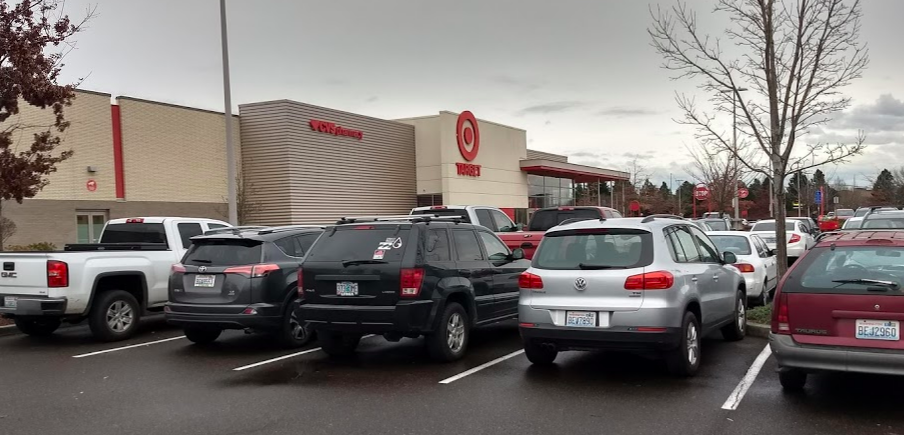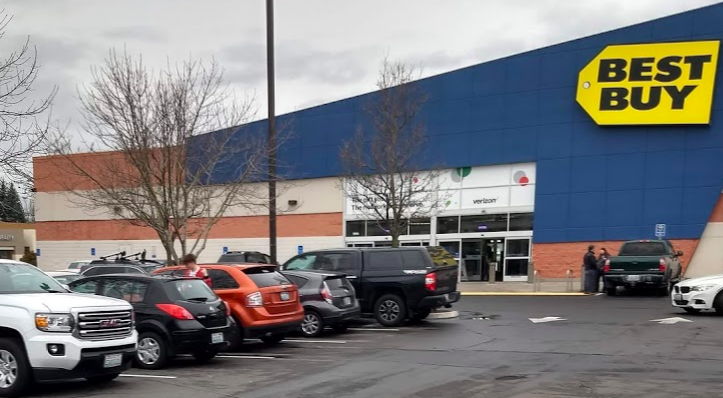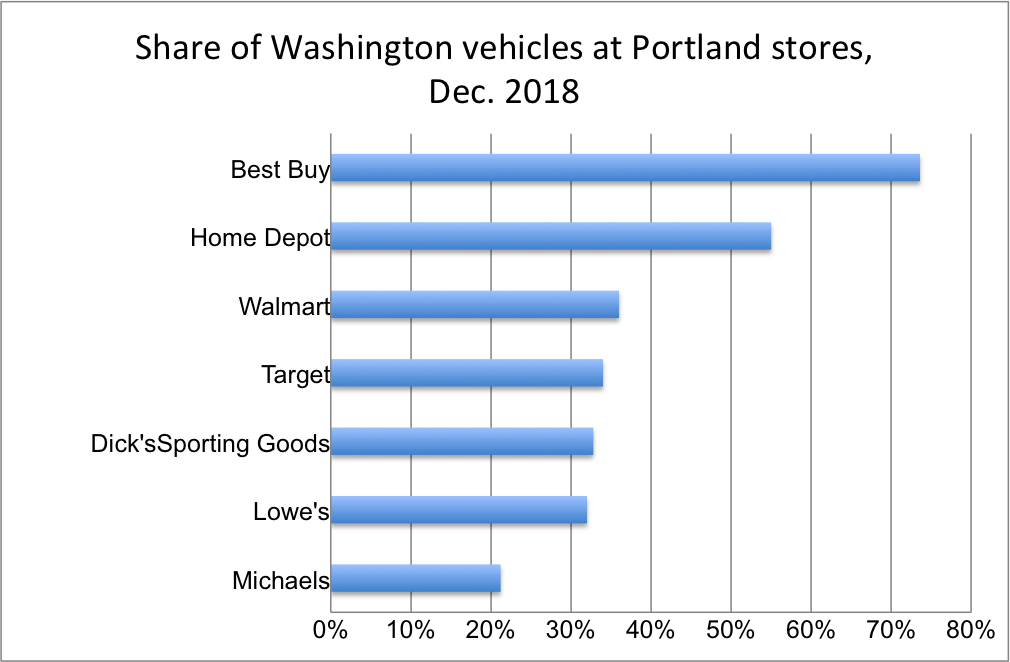Tax free shopping in Oregon saves the typical Southwest Washington household $1,000 per year
Cross border shopping accounts for 10-20 percent of all trips across the I-5 and I-205 bridges
Tax avoidance means we’re essentially paying people to drive and create traffic congestion
Those who live in “the ‘Couv”–Vancouver, Washington–often like to poke at their larger neighbor on the South side of the Columbia River; in the heyday of “Portlandia” for example, Vancouver wags produced their own “The dream of the suburbs is alive in Vancouver,” video in reply. A favorite political slur is to describe someone in favor of light rail or higher density as supporting Portland creep. But much as they complain, Vancouverites actually really, really like their neighbor to the South, because it facilitates what must be the city’s favorite sport: tax evasion, specifically sales tax evasion.
Washington has a sales tax, Oregon doesn’t. In fact, no two adjacent states have more starkly different tax systems that Oregon and Washington. Washington is just one of seven states with no personal income tax, and consequently has a very high state sales tax rate (over 8 percent in most places). Conversely, Oregon is just one of five states with no general retail sales tax, and has one of the nation’s highest personal income tax rates. (Business taxes are also different: Washington taxes gross business receipts; Oregon taxes net business income).
A bit of geography: Clark County Washington sits just across the Columbia River from Portland, Oregon. The county is effectively a suburb of Portland, and has a population of about 475,000. Two Interstate freeways connect Portland to Vancouver.
Several of the region’s major shopping centers are located within a mile of the state border. To the west, along Interstate 5, are the Jantzen Beach and Hayden Island centers; to the east, near I-205 are Cascade Station and a series of big boxes along Airport Way. You’ll find in these areas, for example, a Lowes, two Home Depots, two Targets, two Staples, a Dick’s Sporting Goods, two Best Buys, a Walmart, a Costco, the region’s only Ikea, as well as a host of others: Petco, TJ Maxx, Ross Dress for Less, Pier One Imports. Most of the merchandise in these stores would be taxable to Washington buyers, if they purchased it in Washington.
Estimating Clark County sales tax evasion
How much money does all this cross-border shopping saving Clark County residents? Our estimate is about $120 million annually. We used data from the Washington Department of Revenue and from the U.S. Bureau of Economic Analysis to develop this estimate.
The key to our analysis is looking at the relationship between total personal income (the income of all the households living in an area) and retail sales tax receipts (the amount of taxes from spending on taxable retail sales. Washington State reports retail sales tax collections by county and for the state as a whole, while the U.S. Department of Commerce’s Bureau of Economic Analysis has comprehensive and comparable estimates of personal income earned by households in every county.
For Washington State as a whole, in 2017, taxable retail sales were 155.6 billion and total personal income was about 428.8 billion, meaning taxable sales were about 36.3 percent of personal income. But in Clark County, retail sales tax revenues were just 30.3 percent of personal income–or about one-sixth lower per dollar of personal income than the statewide average. Clark County’s taxable retail sales were $7.2 billion and personal income was 23.8 billion.
The difference is a good estimate of how much sales tax Washington residents avoid on an annual basis. The shortfall in taxable sales in Clark County, compared to the rest of the state is equal to a little more than six percent of personal income, or about $1.5 billion annually. At a tax rate of 8 percent, that works out to tax avoidance in the amount of about $125 million annually. Clark County’s population is about 475,000, which means per capita tax avoidance is roughly $260 per person per year. A Clark County family of four on average saves roughly $1,000 per year in Washington sales taxes by shopping in Oregon.
So while they main complain about Portland, they’re certainly well-compensated for the psychic strain that comes from living next to a city that they apparently don’t seem to like very well.
Technically, like most state’s Washington’s retail levy is a “sales and use tax,” meaning that residents are liable to pay the tax on goods regardless of where they are purchased. But as a practical matter, for most consumer goods, the law isn’t enforced. The state even seems to have some trouble getting Washington residents to pay sales tax on automobiles: the Washington State Patrol has a special unit that surveils local areas to see if automobiles with Oregon license plates are frequently seen.
To be fair, the border isn’t all gravy for Washingtonians. For those who live in Clark County but commute to jobs in Oregon, they–like Oregonians–have to pay income taxes on the income they earn in the state. In 2016, Clark County residents earned about $3.3 billion in taxable income in Oregon and paid a total of about $200 million in Oregon income taxes. About one-third of all Clark County households pay some Oregon income tax, which means that being on the border is an unalloyed good for about two-thirds of all Southwest Washington households.
How tax arbitrage creates traffic congestion
Yesterday, we told the story of how residents of Vancouver Washington save $120 million annually, about 1,000 per household, by shopping in Oregon (which has no sales tax). This loss is a drain on the State of Washington’s public finances, to be sure, but it also has another, little noticed impact: it’s a major contributor to traffic congestion in the Portland metropolitan area.
Nearly all of those shopping trips to avoid sales taxes, we can be sure, are made by private automobile. And all the traffic across the state border (the Columbia River) are on two Interstate highway bridges (I-5 and I-205).
Most of our discussions of transportation focus, appropriately on commuting trips, the weekday travel from home to work and back. Commuting is the single largest category of travel, and the biggest contributor to peak hour travel (with most work trips occurring in the early morning and late afternoon, giving rise to the double-humped nature of traffic congestion.
But the according to the National Household Travel Survey conducted by the US Department of Transportation, shopping trips and related errands are actually the most numerous kind of automobile trips. In 2017, they estimate that the average American household took 580 shopping trips per year , compared to 546 work commute trips per year (Table 5c). The survey also notes that shopping and errand vehicle trips are as numerous at the afternoon peak (5pm) as are work trips (Figure 15).
What this means is that a significant fraction of the travel on our roadways at the peak hour are not the kind of inflexible work trips, but are instead shopping trips–the kind that can more easily be re-scheduled (your boss insists that you be at work at certain hours; stores are open at a wide range of hours for customer convenience).
Sales tax avoidance is a major motive for Washington households to shop in Oregon. In general, they can only do so by driving, and by driving on the two Interstate bridges across the Columbia River. That means that a not insignificant portion of the automobile traffic across the river, including at the peak hour, is fueled by tax avoidance.
Earlier, we estimated that Clark County residents save about $120 million per year in sales taxes by shopping in Oregon. At the roughly 8.4 percent sales tax rate levied in Clark County, that works out to total retail sales of about $1.5 billion per year. It’s hard to know exactly how much households spend on each shopping trip. It’s likely that tax avoidance trips are for larger ticket items (clothes, appliances, electronics) where the sales tax savings would offset the aded time and expense of driving to Oregon, compared to shopping in Washington. (Most groceries are exempt from Washington sales tax, so it’s unlikely that routine food shopping trips would cross the river).
How many shopping trips to Oregon would be required to spend $1.5 billion on items that would be subject to retail sales tax in Washington.
As a rough basis for estimate, we’ll assume that the average shopping trip in Oregon results in spending somewhere between $125 and $250 per trip. (saving the Washington shopper between $10 and $20 per trip). At this rate, the $1.5 billion in spending, that would work between 6 and 12 million shopping trips per year. To put that figure in context, there are about 160,000 households in Clark County, which works out to between 38 and 76 shopping trips per household per year, or about 3 to 6 Oregon shopping trips per month.
All those shopping trips make a significant contribution to automobile traffic across the two Columbia River interstate bridges. On a daily basis, our 6 to 12 million shopping trips works out to between 16,600 and 33.200 trips per day. Each trip represents two crossings of the Columbia River (one going South from Washington to Oregon, and a second crossing returning to Washington). This suggests that sales tax avoidance generates between 33,000 and 66,000 trips across the two Columbia River bridges. The two bridges average about 300,000 trips per day (about 135,000 on the I-5 bridges; and 165,000) on the I-205 bridges, which means that tax avoidance shopping accounts for roughly 10 to 20 percent of the total trips across the Columbia River.
A survey of parking lots in North and Northeast Portland
In December, 2018, on a weekday afternoon, we did a windshield survey of parking lots in major retail shopping centers in north and northeast Portland, just south of the Columbia River. We looked at parking lots in Hayden Meadows and Jantzen Beach (adjacent to I-5), and at Cascade Station and Airport Way, adjacent to I-5 We counted the number of cars in parking lots at major stores and noted what fraction of the vehicles had Washington license plates. Here’s a summary of what we found. The share of Washington vehicles in these parking lots ranged from about 20 percent to 70 percent, and varied according to the type of store. Best Buy–which specializes in televisions, computers, and electronics, was almost 70 percent Washington customers. Michael’s, a hobby and craft store had just 20 percent Washington customers.
Home Depot, Jantzen Beach Shopping Center, Oregon

Target, Cascade Station, Oregon

Best Buy, Jantzen Beach Center, Oregon

These calculations suggest that traffic congestion between Portland and Vancouver is materially affected by tax avoidance. Short of changing one or both of the two state’s tax structures it may be difficult to remove this incentive. But there is another way. Congestion pricing, particularly variable peak hour tolls, could prompt sales tax conscious shoppers to make their Oregon trips at off-peak times. Off-peak shoppers could continue to get their Oregon tax break and also avoid paying a high toll for peak hour travel. The result would be better traffic flow during peak hours for those who had less flexibility in arranging their travel schedules. It’s also worth remembering that it doesn’t take a huge reduction in traffic volumes, particularly at the peak hour, to get traffic to move much more smoothly. Getting shoppers to re-arrange their trips would make a material difference to travel times between the two states.
There’s a coda to our earlier story about the video parody of Portlandia that caricatures Vancouver (“The Dream of Suburbia is alive in Vancouver). At the end of the video, Melanie (the stand-in for Carrie Brownstein) has made it to the mall parking lot in Vancouver where the rest of the cast is singing. Asked what took her so long she says: “I got stuck on the I-5 bridge.” Her ersatz Fred Armisten responds: “Yeah, they need to replace that thing with a bigger bridge–and make Portland pay for it.”
The dream of the suburbs is alive in Vancouver (Youtube)



